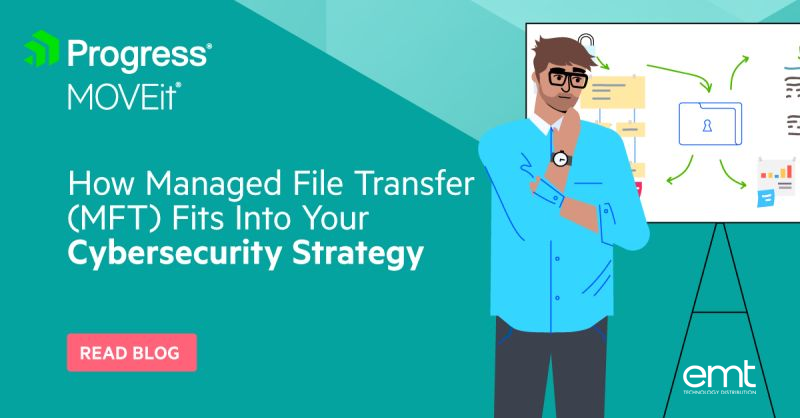There is this feeling of inadequacy that usually surrounds every company’s cybersecurity strategy. It’s never enough.
Even after investing in everything — crossing all the T’s, and dotting the i’s, — executives will always feel like there is still something missing. Many wish that there was an extra mile or two they could go to secure their systems.
Fortunately, there is — and it’s called Managed File Transfer (MFT).
This inadequacy stems from many security strategies overlooking the securing of their data in rest and transit. That said, understanding how Managed File Transfer fits in your security strategy is the missing link; the ribbon that will tie your security strategy together.
Managed File Transfer
More than ever, you need control and visibility over your data movements and infrastructure.
That said, a secure file transfer method, such as Managed File Transfer (MFT), has never been this crucial in your cybersecurity strategy.
You may have gotten by fine without one in 2008, cruised through 2012 without event, and survived 2017 by a whisker — but not this decade.
Look around you, and you’ll be shocked at how much has changed within the few years. Notice the soaring number of endpoints from remote working. Even worse, observe the remote employees walking home with critical system access and the rise of peer-to-peer data transfers.
Then, look at the massive cyber-attacks on the news and in headlines. They’re all related
The Need for Managed File Transfer in Your Cybersecurity Strategy
It’s becoming increasingly clear that a single solution is no longer enough to secure your data infrastructure. It may have worked once, but not anymore.
Like your organization, many companies have developed a cybersecurity stack. Yours is most likely composed of a few systems, strategies, integrations, and protocols that work in tandem to keep your systems foolproof.
For most companies, these systems include strategies such as chaos engineering, reliance on transfer protocols such as SFTP, and integrations such as Managed File Transfer (MFT) with Digital Asset Management (DAM).
With the ever-growing volume of system-critical data, remote work increasing breaches by 137,000, and sophisticated malware attacks, it’s time you made Managed File Transfer (MFT) part of your cybersecurity strategy.
Learn more about MOVEit Managed File Transfer
What Is Managed File Transfer (MFT)?
Managed File Transfer is a software solution that uses encryption and file transfer protocols to transfer files across the different endpoints in your organization securely.
And it goes much further than that. The “managed” part of Managed File Transfer works to give you centralized visibility, access and control over your data infrastructure and internal and external data transfers.
Where Managed File Transfer (MFT) and Cybersecurity Cross Paths
According to Varonis, only 5% of a company’s folders are secure. Protecting data against malicious intent throughout its life cycle requires a system that protects your data both at rest and in transit.
It should offer end-to-end encryption, automation and strict access control. The best solution that offers all this in one package is Managed File Transfer.
Managed File Transfer (MFT) can add the following aspects into your cybersecurity strategy:
1) File Encryption
Managed File Transfer (MFT) is encryption at its finest. It relies on the latest versions of industry-standard encryption protocols such as AES and Secure Hash Algorithm 1 (SHA-1) to secure your data.
Managed File Transfer (MFT) also goes further to provide end-to-end encryption. This type of encryption protects your data both from external agents and your host. This way, it prevents vulnerabilities and loopholes of the host from spreading to your systems.
2) Authentication
Access control has never been more crucial. With your migration from paper-based systems and spreadsheets, having more digital access puts your systems within reach of cyber-attackers.
Moreover, the rise of outsourcing and remote working means that more people than ever have access to your critical system’s data than ever.
Managed File Transfer (MFT) digitizes and simplifies your system access, even for your remote teams. It also offers multi-factor authentication and granular user protection as additional layers of protection against vulnerabilities.
3) Reduce Reliance On Manual Processes
Human error is responsible for 95% of all cybersecurity breaches. Every single manual data transfer process that requires manual input from your team is an attack waiting to happen.
Moreover, over 48% of malicious files are in Microsoft Office emails. With just an iPhone, email address and critical systems access, last year’s employee of the year can unknowingly open your doors to a cyber predator.
Managed File Transfer (MFT) will automate most of your redundant and repetitive processes. These are processes that are usually handled by your team and are targets for phishing attacks and malware.
Visibility
Visibility is another aspect of security that often goes overlooked. According to IBM, the average time for identifying and containing a data breach is 280 days.
This is primarily due to a lack of visibility into organizational data transfer structures. Managed File Transfer (MFT) will give your insight into your data systems. A Managed File Transfer (MFT) dashboard will offer:
- View of file transfer status
- End-point activity status
- Analytics on event history
- Transfer volume expectations
Why You Should Reserve A Spot For MFT In Your Security Strategy
These improvements in security will extend even past your cybersecurity concerns. Embracing Managed File Transfer (MFT) will create a ripple effect that will be felt around your organization.
Some of the benefits that will be an immediate result of adding Managed File Transfer (MFT) to your security stack include:
Migration from Outdated Protocols
It’s way past time to upgrade any aspect of your data’s life cycle that depends on outdated transfer protocols such as FTP and SFTPs.
FTP was created without security in mind, and so any part of your internal and external data transfer that depends on FTP is a disaster waiting to happen.
Managed File Transfer (MFT) presents a rare opportunity to fully migrate your data infrastructure into the latest and most secure transfer protocols such as SSH.
Compliance
You may have noticed that data regulations have only become stricter. Fines are rising, stakes are increasing and the public is taking data privacy more seriously.
Managed File Transfer offers help with regulatory compliance for institutions handling sensitive data.
Scalability
Your data transfer systems could be secure as they are. But unanticipated increases in data transfer volume or gradual growth may put a strain on your systems leading to vulnerabilities.
Managed File Transfer (MFT) offers performance through its load testing and load balancing features. With this transfer protocol, your systems are better prepared for unprecedented increases in data transfers and their subsequent workflows.
Cost-Savings
Outright, data breaches are costly, and investing in secure systems now protects you from business-shattering costs later.
Moreover, Managed File Transfer (MFT) will save your business lots of money through its efficiency. By cutting down on manual processes, your business gets to save on labor costs.
With MOVEit, securing Your Critical Data Has Never Been This Easier
MOVEit is your go-to solution if you want to make Managed File Transfer (MFT) part of your cybersecurity strategy.
MOVEit leverages all aspects of managed file transfer, including secure protocols such as SSH and encryption protocols, to ensure your sensitive data remains secure at rest and in transit.
Join thousands of organizations that benefit each day from robust and secure transfers with MOVEit. For more information, contact us today, and we will be more than willing to help.
Source : https://www.ipswitch.com/blog/how-managed-file-transfer-fits-in-your-cybersecurity-strategy








